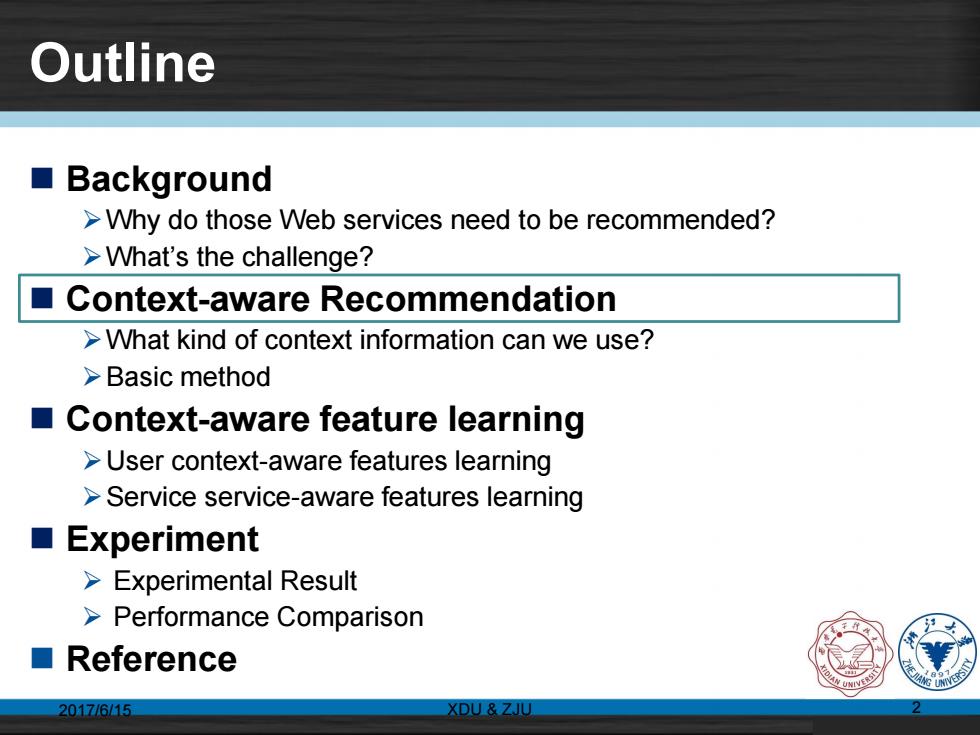
Outline ■Background >Why do those Web services need to be recommended? >What's the challenge? Context-aware Recommendation >What kind of context information can we use? >Basic method Context-aware feature learning >User context-aware features learning >Service service-aware features learning ■Experiment >Experimental Result >Performance Comparison ■Reference 2017/615 XDU ZJU
Background ➢Why do those Web services need to be recommended? ➢What’s the challenge? Context-aware Recommendation ➢What kind of context information can we use? ➢Basic method Context-aware feature learning ➢User context-aware features learning ➢Service service-aware features learning Experiment ➢ Experimental Result ➢ Performance Comparison Reference Outline 2017/6/15 XDU & ZJU 2

Background Generdestricted Web Service WSDL(XML) Interface SOAP >A Web service is a self-describing programmable application used to achieve interoperability and accessibility over a network 'Services Computing;Zhang,L.et WS=WSDL+Interface+SOAP Popularity >Amazon Relational Database Service >Amazon Simple Storage Service R D 如果请求中包含了P以证授权态数,则返回值中包含当前爱权用户的对于这本书裙收#的k。关于AP似 证须权的信息请参阅P爱枫说明 ■ Other similar component Thttp://api.doubancom/baok/subjeet/(subje They are almost >Open API: the same 他可以涌过s0n支并10位、13位,而且支持在其中 Douban,Sina Weibo,RenRe Thttp://spi.douban.com/bk/subjee/isn/[isbaID] -Amazon,Facebook,MySpac 20171615 XDU ZJU GET http://spi.douban.com/book/subjeet/isbn/9T87543639133
Background Web Service ➢ A Web service is a self-describing programmable application used to achieve interoperability and accessibility over a network ~ ‘Services Computing’, Zhang, L. etc. 2017/6/15 3 Other similar component ➢ Open API: − Douban, Sina Weibo, RenRen, 51.com − Amazon, Facebook, MySpace, Twitter, eBay, Google Maps WSDL(XML) Interface SOAP WS=WSDL+Interface+SOAP Popularity ➢ Amazon Relational Database Service ➢ Amazon Simple Storage Service etc. They are almost the same Generalrestricted XDU & ZJU
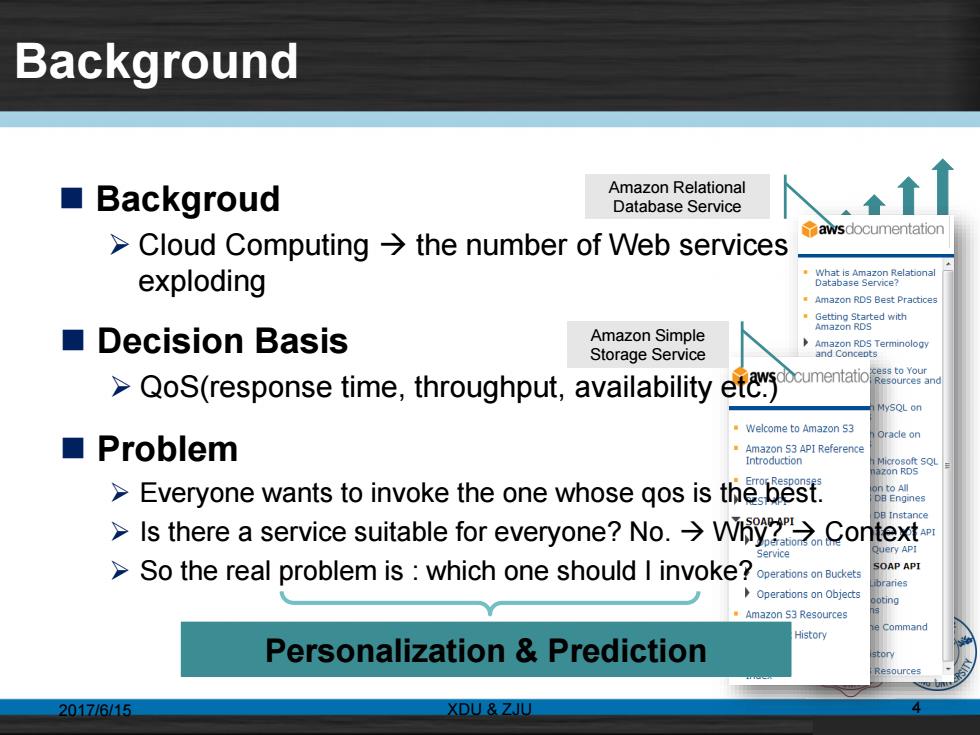
Background ■ Backgroud Amazon Relational Database Service .t awsdocumentation >Cloud Computing>the number of Web services exploding elational Amazon RDS Best Practices maron ged with ■Decision Basis Amazon Simple Storage Service nmnlog >QoS(response time,throughput,availability et MySQL an Welcome to Amazon S3 Problem Oracle on >Everyone wants to invoke the one whose gos is the best. DB Instance >Is there a service suitable for everyone?No.>WhContext Service uery AP >So the real problem is which one should I invoke?obrton o Budkets SOAP API aries Operations on Objects ·Amazon S3 Resources e Command History Personalization Prediction tory 2017/615 XDU ZJU
Background Backgroud ➢ Cloud Computing the number of Web services is exploding 2017/6/15 4 Amazon Relational Database Service Amazon Simple Storage Service Problem ➢ Everyone wants to invoke the one whose qos is the best. ➢ Is there a service suitable for everyone? No. Why? Context ➢ So the real problem is : which one should I invoke? Personalization & Prediction Decision Basis ➢ QoS(response time, throughput, availability etc.) XDU & ZJU
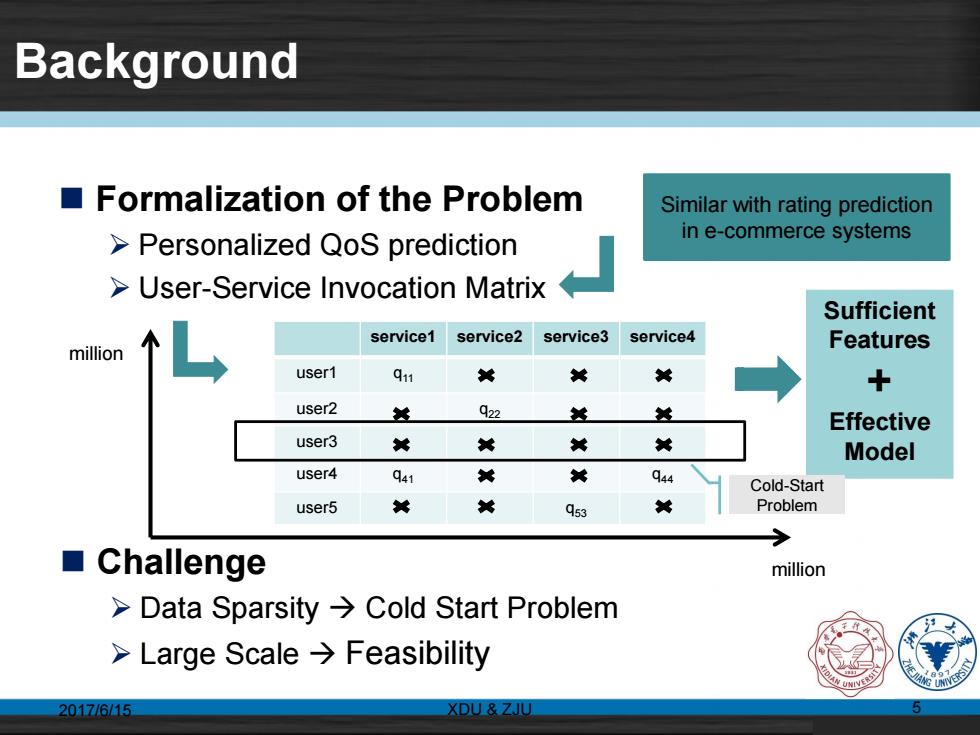
Background Formalization of the Problem Similar with rating prediction >Personalized QoS prediction in e-commerce systems User-Service Invocation Matrix Sufficient service1 service2 service3 service4 million Features user1 911 关 年 然 + user2 法 q22 然 益 Effective user3 关 关 关 关 Model user4 q41 关 关 q44 Cold-Start user5 关 q53 Problem → ■ Challenge million >Data Sparsity>Cold Start Problem >Large Scale Feasibility 20171615 XDU ZJU
Background Formalization of the Problem ➢ Personalized QoS prediction ➢ User-Service Invocation Matrix 2017/6/15 5 service1 service2 service3 service4 user1 q11 user2 q22 user3 user4 q41 q44 user5 q53 ➢ Large Scale Feasibility Challenge ➢ Data Sparsity Cold Start Problem million million Sufficient Features + Effective Model Cold-Start Problem Similar with rating prediction in e-commerce systems XDU & ZJU
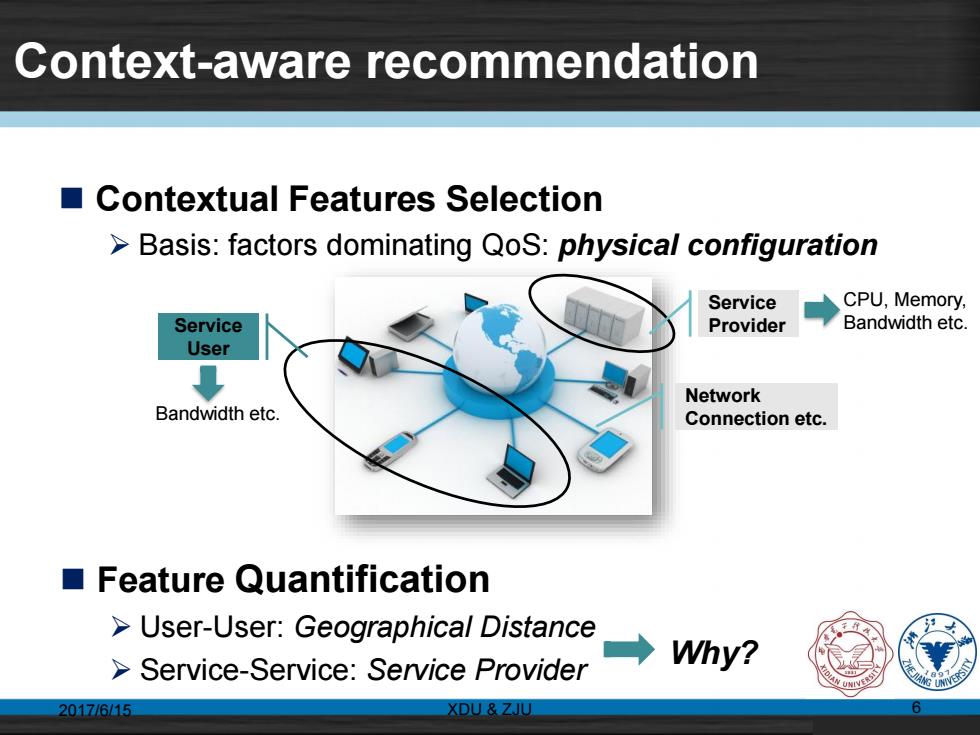
Context-aware recommendation Contextual Features Selection Basis:factors dominating QoS:physical configuration Service CPU,Memory, Service Provider Bandwidth etc. User Network Bandwidth etc. Connection etc. Feature Quantification >User-User:Geographical Distance Service-Service:Service Provider →Why? 2017/1615 XDU ZJU
Context-aware recommendation Contextual Features Selection ➢ Basis: factors dominating QoS: physical configuration 2017/6/15 6 Service User Service Provider Network Connection etc. CPU, Memory, Bandwidth etc. Bandwidth etc. Feature Quantification ➢ User-User: Geographical Distance ➢ Service-Service: Service Provider Why? XDU & ZJU
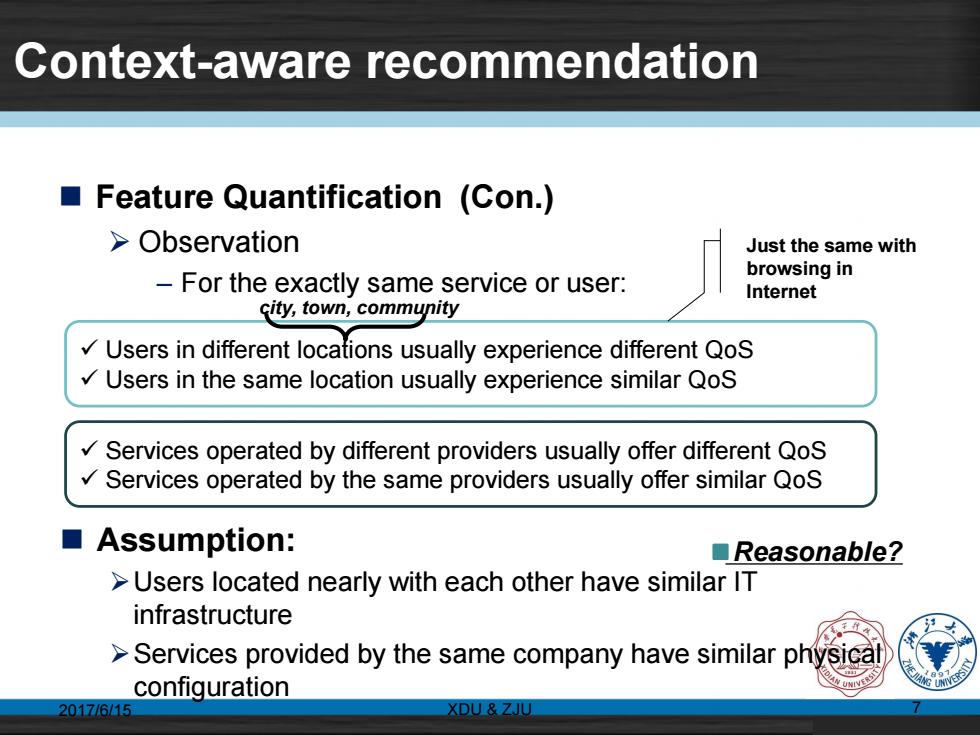
Context-aware recommendation Feature Quantification (Con.) >Observation Just the same with browsing in -For the exactly same service or user: Internet city,town,community Users in different locations usually experience different QoS Users in the same location usually experience similar QoS Services operated by different providers usually offer different QoS Services operated by the same providers usually offer similar QoS ■Assumption: ■Reasonable? >Users located nearly with each other have similar IT infrastructure >Services provided by the same company have similar physica configuration 201716115 XDU ZJU
Context-aware recommendation Feature Quantification (Con.) ➢ Observation – For the exactly same service or user: 2017/6/15 7 Assumption: ➢Users located nearly with each other have similar IT infrastructure ➢Services provided by the same company have similar physical configuration ✓ Users in different locations usually experience different QoS ✓ Users in the same location usually experience similar QoS city, town, community Just the same with browsing in Internet ✓ Services operated by different providers usually offer different QoS ✓ Services operated by the same providers usually offer similar QoS Reasonable? XDU & ZJU
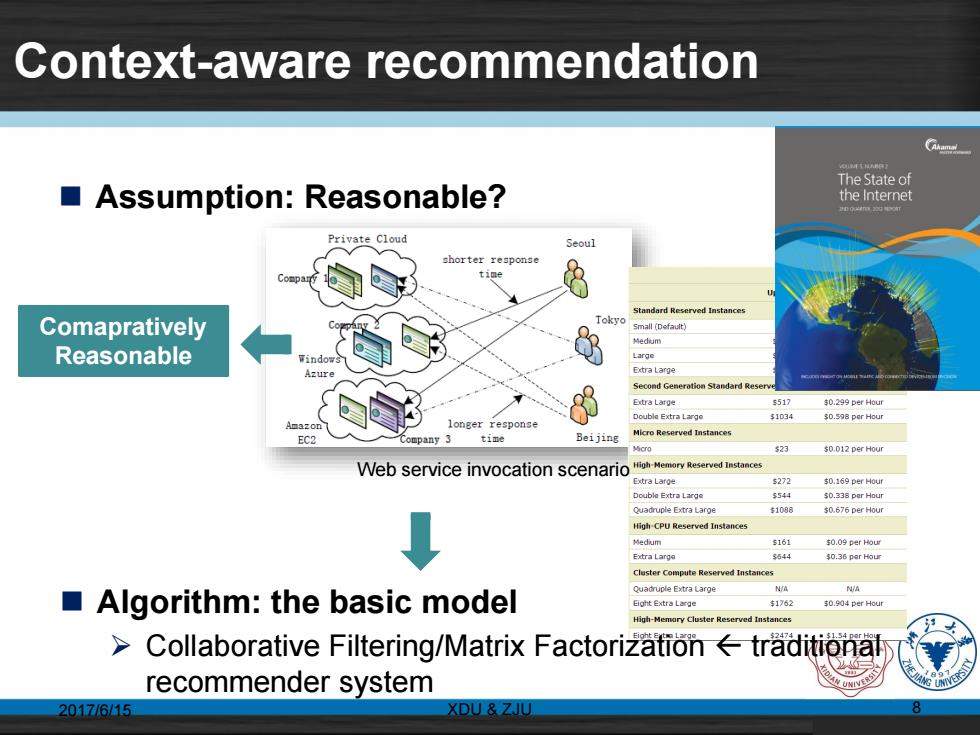
Context-aware recommendation The State of Assumption:Reasonable? the Internet Private Cloud Seoul shorter response time Standard Reserved Instances Comapratively Small (Defaut) Reasonable Large Et灯e Large ration Standard Re Extra Large s517 50.299 per Hour Doubie Extra Large 1034 longer response EC2 Company 3 time Beijing Micro Reserved Instances 52 $0.012 per Hour Web service invocation scenario Extra Large 5272 $0.169 per Hour Doubla Extra Large 5544 $0.338 par Hour Quadruple Extra Large 51098 $0.676 per Hour High-CPU Reserved Instances 5161 09 per Hour Extra Large 544 $0.36 per Hour Cluster Compute Reserved Instances Algorithm:the basic model Quadruple Extra Large N/A N/A Eight Extra Large 1762 50.904 per Hour High-Memory Cluster Reserved Instances >Collaborative Filtering/Matrix Factorization traditiona recommender system 2017/615 XDU ZJU
Context-aware recommendation Assumption: Reasonable? 2017/6/15 8 Comapratively Reasonable Web service invocation scenario Algorithm: the basic model ➢ Collaborative Filtering/Matrix Factorization traditional recommender system XDU & ZJU
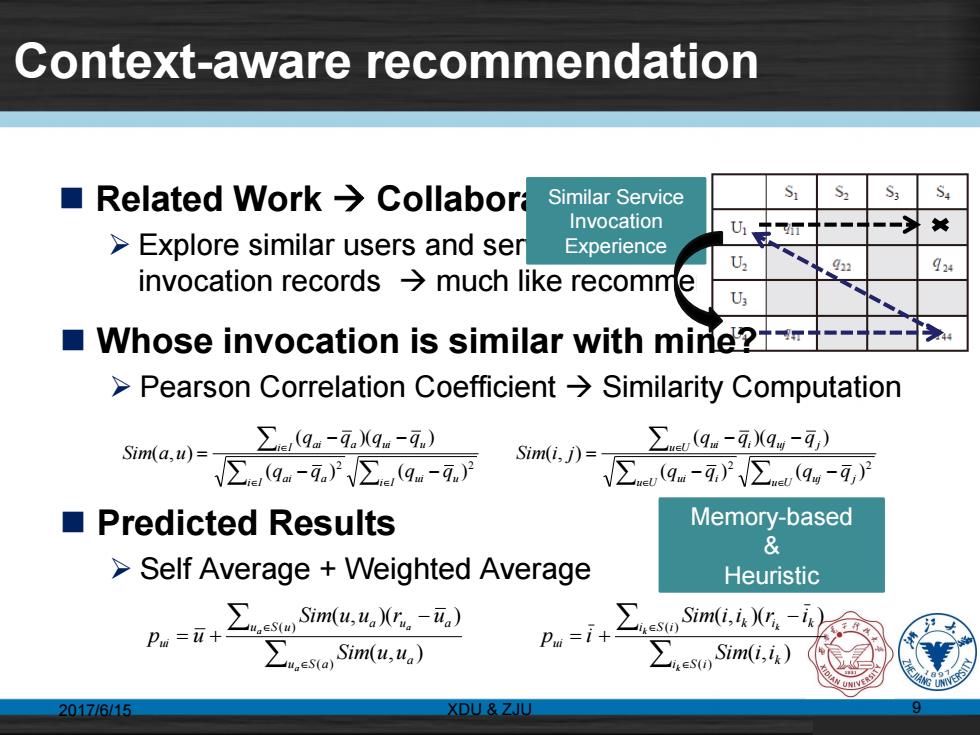
Context-aware recommendation ■Related Work→Collabor Similar Service S: Invocation U >Explore similar users and ser Experience U 924 invocation records much like recomm U Whose invocation is similar with mine? >Pearson Correlation Coefficient Similarity Computation Sim(a,w0)= ∑(gn-a,g。-) ∑e(9。-q,gy-4,) V∑g.-.}V∑9.-了 5m-2.-a.a,- ■Predicted Results Memory-based & >Self Average Weighted Average Heuristic Pu=u+ ∑est Sim(.,XL,-a) ∑eo Sim,4X.- ∑ Pu=i+ Sim(u,ua) ∑esSim(,i.) 20171615 XDU ZJU
Related Work Collaborative Filtering ➢ Explore similar users and services through their historical invocation records much like recommender systems Context-aware recommendation 2017/6/15 9 Similar Service Invocation Experience Whose invocation is similar with mine? ➢ Pearson Correlation Coefficient Similarity Computation i I ui u i I ai a i I ai a ui u q q q q q q q q Sim a u 2 2 ( ) ( ) ( )( ) ( , ) U u U uj j u ui i u U ui i uj j q q q q q q q q Sim i j 2 2 ( ) ( ) ( )( ) ( , ) Predicted Results ➢ Self Average + Weighted Average ( ) ( ) ( , ) ( , )( ) u S a a u S u a u a ui a a a Sim u u Sim u u r u p u ( ) ( ) ( , ) ( , )( ) i S i k i S i k i k ui k k k Sim i i Sim i i r i p i Memory-based & Heuristic XDU & ZJU
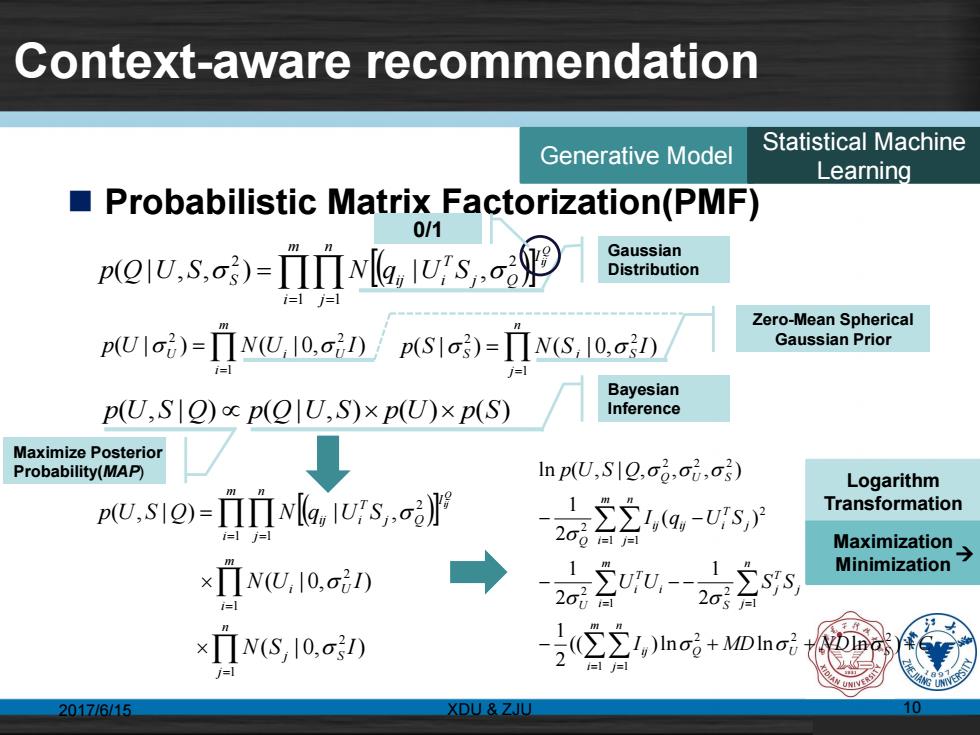
Context-aware recommendation Statistical Machine Generative Model Learning Probabilistic Matrix Factorization(PMF) 0/1 p(QIU.S.a:)-IITINla,lU!s,. Gaussian Distribution Zero-Mean Spherical p(UIoi)=IIN(U,I0.ciD)/p(SIog)=IIN(S,10.oD) Gaussian Prior Bayesian p(U,S O)p(lU,S)xp(U)xp(S) Inference Maximize Posterior Probability(MAP) Inp(U,SIQ.oo.oi.oj) Logarithm P(U.SIO)=IIIIN[a,IU!s, 1 221,4,-05,y Transformation 22习 Maximization.→ ×1NU,I0,o0 Minimization ×ΠN(S,10,oI) 2空,mj+oni =1=1 1= 2017/615 XDU ZJU
Context-aware recommendation Probabilistic Matrix Factorization(PMF) 2017/6/15 10 m i n j I j Q T S ij i Q ij p Q U S N q U S 1 1 2 2 ( | , , ) | , Generative Model Statistical Machine Learning m i U i U p U N U I 1 2 2 ( | ) ( | 0, ) n j S j S p S N S I 1 2 2 ( | ) ( | 0, ) p(U, S | Q) p(Q |U, S) p(U) p(S) n j j S m i i U m i n j I j Q T ij i N S I N U I p U S Q N q U S Q ij 1 2 1 2 1 1 2 ( | 0, ) ( | 0, ) ( , | ) | , Gaussian Distribution 0/1 Zero-Mean Spherical Gaussian Prior Bayesian Inference Maximize Posterior Probability(MAP) I MD ND C U U S S I q U S p U S Q Q U S m i n j ij n j j T j S m i i T i U m i n j j T ij ij i Q Q U S (( )ln ln ln ) 2 1 2 1 2 1 ( ) 2 1 ln ( , | , , , ) 2 2 2 1 1 1 2 1 2 1 1 2 2 2 2 2 Logarithm Transformation Maximization Minimization XDU & ZJU
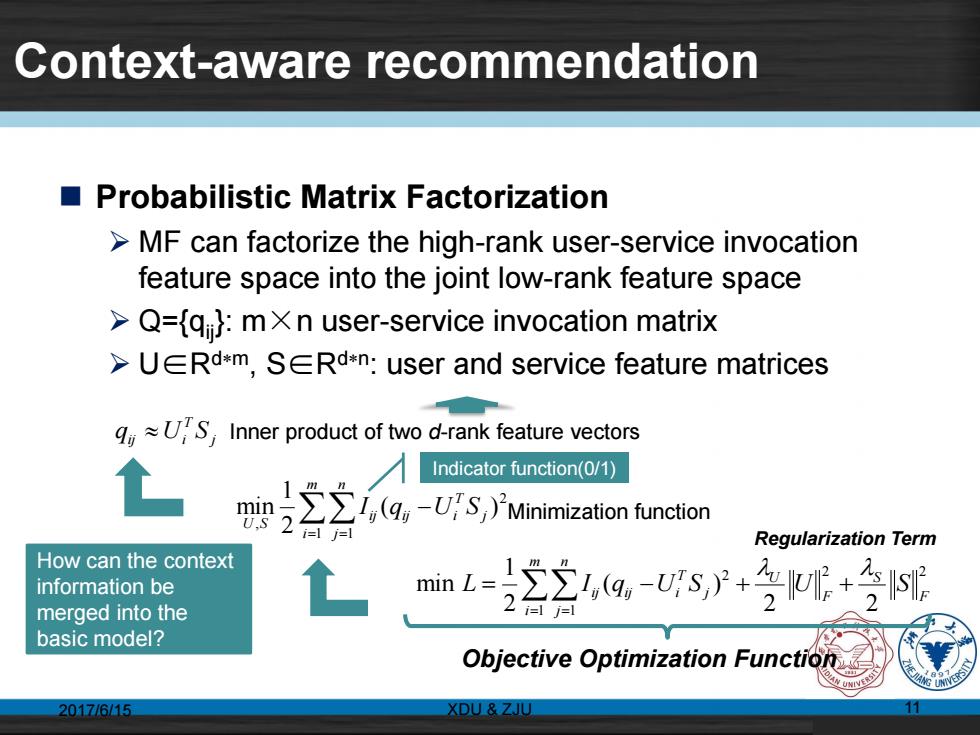
Context-aware recommendation ■ Probabilistic Matrix Factorization >MF can factorize the high-rank user-service invocation feature space into the joint low-rank feature space >Q={q):mXn user-service invocation matrix >UERd*m,SERd*n:user and service feature matrices US,Inner product of two d-rank feature vectors Indicator function(0/1) Shinimizaton functon i=1=1 Regularization Term How can the context information be merged into the m-2空4aEN阳 basic model? Objective Optimization Function 20171615 XDU ZJU
Context-aware recommendation Probabilistic Matrix Factorization ➢ MF can factorize the high-rank user-service invocation feature space into the joint low-rank feature space ➢ Q={qij}: m×n user-service invocation matrix ➢ U∈Rdm, S∈Rdn : user and service feature matrices 2017/6/15 11 j T qij Ui S m i n j j T ij ij i U S I q U S 1 1 2 , ( ) 2 1 min 2 2 1 1 2 2 2 ( ) 2 1 min F S F U m i n j j T L I ij qij Ui S U S Inner product of two d-rank feature vectors Minimization function Objective Optimization Function Indicator function(0/1) How can the context information be merged into the basic model? Regularization Term XDU & ZJU